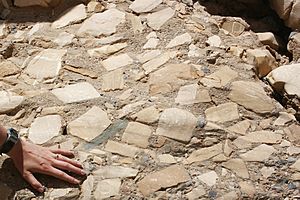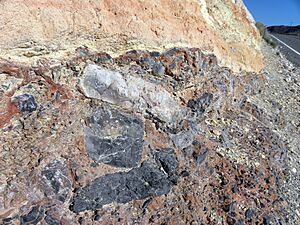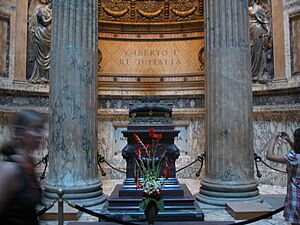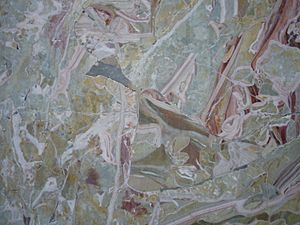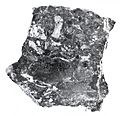Breccia facts for kids

Breccia is a type of rock that looks like it's made from broken pieces. Imagine a puzzle where all the pieces are sharp and jagged, not smooth. That's what breccia is like! It's formed when sharp, broken bits of minerals or other rocks get stuck together. They are held by a fine-grained material called a matrix, which acts like a natural cement.
Rocks that are made from pieces of older rocks are called clastic rocks. Breccia is one type of clastic rock. Another type is called a conglomerate. The main difference between them is the shape of their pieces. In breccia, the rock fragments are sharp and angular. In conglomerates, the pieces are smooth and rounded, like pebbles you'd find in a river.
How Does Breccia Form?
Breccia can form in many different ways. Scientists give them different names based on how they were created. Some common types include sedimentary breccia, tectonic breccia, igneous breccia, impact breccia, and hydrothermal breccia.
Here's a simple way to think about how it forms:
- First, tiny bits of rock or minerals settle down, often in water, forming layers of sediment.
- Over a long time, these sediments can turn into sedimentary rock.
- Then, something powerful happens. This could be an earthquake, a volcano, or even a meteorite hitting the Earth. This event breaks the rock into many sharp, jagged pieces.
- Later, these broken pieces get cemented together by new minerals or other sediments. This creates a brand new rock, which is a breccia! When you look closely, you can still see the pieces of the original rock inside.
Breccia in Art and Buildings
Some types of breccia, especially those made from marble, can be incredibly beautiful. They have unique patterns and colors because of the different rock fragments inside. This makes them popular for decoration.
For example, the famous Pantheon in Rome is full of amazing marble. Many of these are actually breccias! It has two huge columns made of a breccia called pavonazzetto. This special stone comes from a place called Phrygia, which is in modern-day Turkey.
Pavonazzetto gets its name from its very colorful look. It reminds people of a peacock's feathers. In Italian, "pavone" means "peacock." This shows how beautiful and striking breccia can be when used in architecture and art.
Images for kids
-
Giant breccia (left) at Titus Canyon Narrows, Death Valley National Park, California.
-
Unusual breccia cemented by blue azurite and green malachite, from the Morenci Mine, Arizona.
-
Alamo bolide impact breccia (from the Late Devonian period) near Hancock Summit, Pahranagat Range, Nevada.
-
Silicified and mineralized breccia. The light gray part is mostly dolomite with a little quartz. The dark gray part is jasperoid and ore minerals. A small vein at the bottom has sphalerite in carbonates. From the Pend Oreille mine, Pend Oreille County, Washington.
See also
 In Spanish: Brecha (geología) para niños
In Spanish: Brecha (geología) para niños


